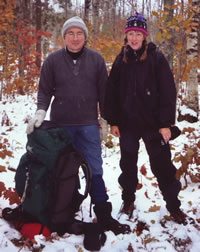|
Every wilderness trek consists of some
memorable events interspersed with routine camp chores and
periods of less memorable travel through the countryside.
The latter are usually accompanied by introspection
or by pondering of solutions to such trip-related problems
as how to make one's pack lighter or fix the strap that keeps
coming loose.
When I think of our November backpacking
trip on the NCT, these are some of the things I remember:
Driving to the trailhead after
midnight with icy crystals hitting the windshield and
the undisturbed expanse of snow on Dick Road glittering
in my headlights.
Sleeping in the Neon near the
trailhead and being awakened by the quacking of ducks
on the Pine River and finding the car and the surrounding
forest covered with several inches of white stuff. The
first snow of the winter is always beautiful.
The first bivouac of the trip
was near a bend on Black Creek. As we sat talking in the
circle of light from a small campfire, a beaver repeatedly
reminded us with loud slaps of her tail that we were in
her territory.
Snow fleas were out in abundance.
In some places it looked like the snow had been sprayed
with black paint. Filling our bottles at one pond, we
had trouble not acquiring large numbers of them along
with the water and we joked that we would be making snow
flea tea.
Another pleasant bivouac was
on Arbutus Lake. Unable to reach a consensus on the options
of camping on a ridge with a view of the water or in a
more sheltered location, we split into two groups: Ridge
People and Swamp People.
Michael found a unique hunter's
blind just south of Arbutus Lake. Dug well into the ground,
heavily covered  and
with only one small shooting port, it looked as if the
builder thought the deer might return fire. and
with only one small shooting port, it looked as if the
builder thought the deer might return fire.
Aaron Cliff,
the tunnel rat
from Marquette, Michigan, volunteers to
enter the dark,
undergroud bunker
and reveal it secrets.
(Photo by Mary Powell)
View Gail Staisil's
Photo
Album from this trip
Betchler Swamp was impressive--sweeping
expanses of grassy wetland in pale shades of yellow dotted
with the broken gray snags of long dead trees. It was
especially pretty with piles of dark clouds as a backdrop. It was impressive in another way too--in
the amount of effort required to cross just a small segment
of it off-trail.
as a backdrop. It was impressive in another way too--in
the amount of effort required to cross just a small segment
of it off-trail.
A small beaver pond
backs up the
headwaters of
the Pine River as
it flows out of
the expansive
Betchler Swamp.
(Photo by Gail Staisil)
View Gail Staisil's
Photo
Album from this trip
I enjoyed returning to camp at
night with the glow of the campfire backlighting the tarp,
creating a giant candle lantern.
Autumn colors are always pretty,
but highlighted against the snow they were outstanding.
Leaves of every color lay on top of the snow too, providing
an endless collage along the trail.
The last time I looked for an answer to
this question, back in junior high, research hadn't gotten
that far yet. Returning home from this trip though, I found
the latest theories in the October 26 issue of Science
News.
It said that cold snaps do varying damage
to the intracellular mechanisms in leaves. When the process
is slow, chlorophyll breaks down and as its green color disappears,
the underlying color of the leaf, yellow or brown, is revealed.
Red is a little more complex.
Some plants have evolved the ability to
produce anthocyanins in response to cold damage. These chemicals
make the leaf red and probably perform a variety of protective
functions, which allow the leaf to continue to produce food
for the plant for a while. 
Mike Ugorowski
of Flint, Michigan
and Gail Staisil
of Midland, Michigan
take a break
among the freshly fallen leaves
on the North Country Trail.
(Photo by Gail Staisil)
View Gail Staisil's
Photo
Album from this trip
Experiments indicate that anthocyanins
absorb free radicals and protect the leaf from UV damage.
They may also give the fluid in the leaves lower osmotic potential,
preventing dehydration, and they reduce further cold damage
by lowering the temperature at which the water in the leaves
freeze.
Other researchers have found that anthocyanins
may protect damaged leaves against fungal infection and leaf
color may give insects information as to which trees are most
vulnerable to attack.
Every trip poses new questions for me and
I spend some time in between trips looking for the answers.
On my next in December, I'm looking forward to finding out
more about what happens to the woods in the winter....
Read
another journal...
|



 and
with only one small shooting port, it looked as if the
builder thought the deer might return fire.
and
with only one small shooting port, it looked as if the
builder thought the deer might return fire. as a backdrop. It was impressive in another way too--in
the amount of effort required to cross just a small segment
of it off-trail.
as a backdrop. It was impressive in another way too--in
the amount of effort required to cross just a small segment
of it off-trail.